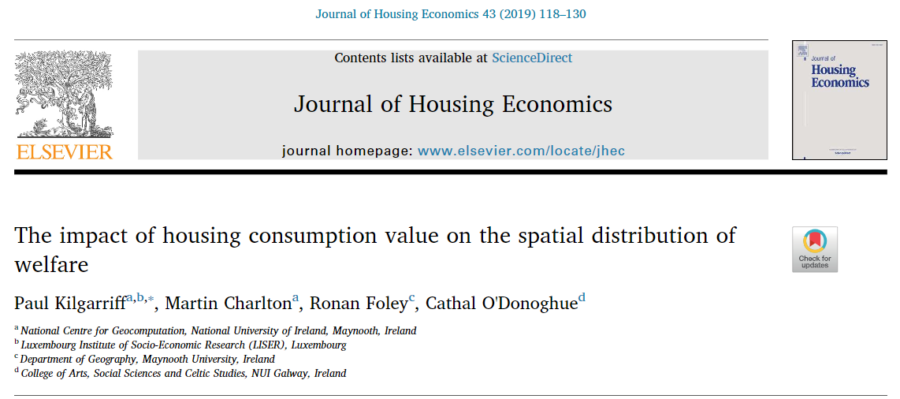https://www.sciencedirect.com/science/article/pii/S1051137718301293
The measure of a household’s income should include not only monetary components such as job salary but also non-monetary components and in-kind benefits, such as imputed rent. Imputed rent is the rent an owner can expect to receive were the house on the rental market. Being an owner-occupier does not provide a rental income however, it saves the owner from having to pay market rent. This is turn can increase a household’s potential to consume other products and services.
The measure of a household’s income should include not only monetary components such as job salary but also non-monetary components and in-kind benefits, such as imputed rent. Imputed rent is the rent an owner can expect to receive were the house on the rental market. Being an owner-occupier does not provide a rental income however, it saves the owner from having to pay market rent. This is turn can increase a household’s potential to consume other products and services.
Results show that the imputed cash flows from property ownership decreases the income share of those at the bottom of the income distribution and is inequality increasing, except in the case of those aged 65 +. Spatially the benefits of housing are greatest in urban areas where property values are highest. The small area measurements of imputed rent highlight the dis-equalising impact imputed rent and housing wealth has on inequality; the rich being able to consume more housing and thus have higher imputed rents.
Increases inequality from a Gini of 0.37159 to 0.38595.
A reverse mortgage/annuity (RMA) enables owner-occupiers to use their home as equity to buy an annuity, which provide them with regular payments, without the need to move out or sell the house therefore providing security of tenure. Without including reverse mortgage/annuity in the analysis, the household would leave behind a significant amount of equity,which is then bequeathed to descendants contributing to inequality. Using reverse mortgage/annuity however treats households as separate units as the household will consume the value of the property before death. Households can over consume to make up for periods of under consumption, i.e. when paying a mortgage. Reverse mortgage/annuity has the potential to financially protect households 65 + by acting as an additional pension, they have paid into over the term of the mortgage. The stream of consumption value provided by housing compensates the elderly who are ‘cash poor but asset rich’.
Policy Implications
After accounting for housing costs in the form of rent and mortgage payments and housing benefits in the form of imputed rent and reverse mortgage/annuity, the spatial distribution of welfare changes. On average the income share of the Greater Dublin Area (GDA)increases, however when the movers are examined, the high rents and property values and overall benefits to owner occupiers in the GDA, are masking the high costs young renters face. This highlights the importance of examining issues such as housing inequality at a detailed spatial scale as opposed to aggregate totals. However, overall the net gain to owner-occupiers does not exceed the net loss to non-owner-occupiers and inequality nationally increases. The inequality measures show that overall housing costs and benefits are having a regressive impact on the income distribution with those at the lower end of the income distribution disproportionately affected. The income share of lower groups decreases after net imputed rent.
In terms of policy implications, a tax on imputed rent should be examined which may reduce the inequality between those who own a house and those who are renting. The current LPT is attempting to address this however the tax is levied on all properties, this is despite private renters not receiving the same level of benefits from housing as owner-occupiers.The LPT should account for the variation in housing benefits across the life-cycle. Effective implementation may incentivise those in the older age categories to take out a reverse mortgage/annuity.
Increased uptake of RMA may result in the older age categories consuming the housing wealth as opposed to bequeathing.This can address issues relating to the inequality of inherited wealth. The high rental values particularly in the GDA may hinder an individual’s ability to save and eventually draw down a mortgage. Solutions are required to increase an individual’s potential to save. There are clear benefits to owner-occupation especially for the elderly. If current trends of decreasing home ownership levels continue, future elderly groups will be particularly vulnerable, as they would not have the financial safety net in the form of a housing asset.
Methodology
This study examined the impact of net imputed rent on the distribution of income in a spatial context. The spatial impact of net imputed rent, mortgage payments, private rent, public rent(social housing schemes) and reverse mortgage/annuity on the spatial distribution of disposable income was examined for the year 2011. A spatial microsimulation model, simulated model of the Irish local economy (SMILE), was used to simulated disposable income at a detailed spatial scale. Rental and property values are estimated at a spatial scale adopting the kriging methodology. The created rental and property data were merged into the SMILE simulated dataset to examine the impact of housing on the spatial distribution of disposable income at a small area level.

Funding
This research was funded under the John and Pat Hume Doctoral Awards at Maynooth University.

